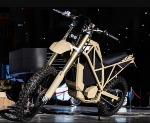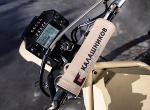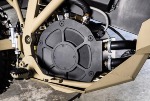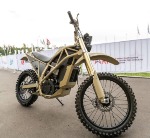- Likes
- 4,057
- Location
- Lake Havasu City, AZ
Kalashnikov, written by Ron @spinningmagnet
Source: Kalashnikov making an electric motorcycle, the SM-1 | ElectricMotorcycle.com | The Electric Revolution Starts Here
Kalashnikov making an electric motorcycle, the SM-1

The Russian company Kalashnikov is one of the most famous names in the world, but it is due to their association with the AK-47 assault rifle. That being said, they are now a large and diverse corporation with a variety of military and police contracts. One of their latest developments is…an electric motorcycle.
________________________________
The Kalashnikov CV-1 electric car
This electric car is a very practical 4-door hatchback, and it “looks like” the body is identical to a pre-1982 orphaned car model called IZh 2125, also known as the Moskovitch 1500 Kombi. Kind of like howthe White Zombie race car was a 1972 Datsun 1200 sedan. Kalashnikov had produced some of them under license, so it follows that they dusted off the old dies that stamped-out the Moskovich body panels, and began making a few to see how it would go. I mean, why re-invent the wheel?
IZh is a subsidiary of Kalashnikov (IZh is roughly translated as [city of] Izhevsk Mechanical Works) and they also began producing motorcycles in 1928. That may sound odd, but during WWII, the Singer sewing machine company from the United States was contracted to make Colt .45-caliber semi-auto pistols, and the General Electric company (famous for motors, generators, and electrical appliances) was contracted to begin making jet engines for aircraft. And before you ask, yes…Kalashnikov still makes guns.

The Kalashnikov CV-1 electric car. The most noticeable change from the Moskovich car donor is the LED headlights to make it look more modern.

The world “infamous” AK-47 assault rifle (Avtomat Kalashnikova, model of 1947), used by every Russian and Soviet ally through the years, including millions of Chinese and dozens of countries. The person holding it up is some old guy named Mikhail.

Kalashnikov / IZh has won the contract to supply electric motorcycles to the police for the 2018 World Cup soccer matches. This is the first time that Russia has hosted the World Cup. The electric motorcycles that they released roughly a year ago are produced by IZh, who began producing gasoline-powered motorcycles in 1928, and their first electric model was called the “Pulsar” [пульсар], seen on the dashboard.

The police version of Kalashnikov’s earliest electric IZh Pulsar models.
________________________________

The dashboard of the new Kalashnikov SM-1
The large “31” shown on the dashboard indicates the battery is at a 31% state of charge, and the battery icon on the left shows 31-Ah of capacity left (the full battery is claimed to have 98-Ah). On the bottom-left is the voltage which is reading 122V here, but the voltage of a full pack is said to be 125V. The battery is reported to be the very safe LiFePO4 chemistry, which is usually regarded to be fully charged at 3.65V per cell, so I am guessing the Kalashnikov battery pack is 30-cells in series (30S).
125V X 98-Ah equals 12,250-WH (Watt-Hours) of range. Bottom-center on the dashboard is the Amps being used, and bottom-right is the Watts.
The “98:15” readout is NOT an odometer, but I suspect it reads the number of minutes and seconds the bike has been running, since the remaining volts and amp-hours do NOT track in a linear fashion, and the time it has run would be useful to know. The stock battery has 98-Ah, so 31-Ah left means it used 67-Ah riding for 98 minutes? If so, it wasn’t running very efficiently, but also the riding style has a huge effect on how much battery you are burning per minute of run-time…even so, an hour and a half isn’t horrible for using 70% of the pack, and it fits the claimed range of 150-km / 93 miles.
The police bike promotional video is claiming 15-kW (15,000 watts), and at 125V, that would result in a controller that can output 120 amps. Other than the LiFePO4 chemistry (and liquid-cooled motor), this system has a lot on common with the Zero brand of motorcycles.
The “DNRtE” on the dashboard relates to the round LED’s just above each letter. Drive, Neutral, Reverse, unknown, unknown. Top speed is claimed to be 90 km/h (55-MPH), and range is claimed to be 150-km (93 miles).

Tiny headlights with high intensity LEDs are the current trend for motorcycles. So are the inverted forks, with the fatter section at the top.

The motor and hydraulic master-cylinder to the rear brakes.
The home page for Kalashnikov states that the motor is a brushless DC liquid cooled unit, and the pictures bear this out The only new info I can provide is that is is highly likely an inrunner, very similar to the Zero brand motorcycles, with the exception that Zeros are air-cooled and liquid-cooling is a performance trick that Alta motorcycles uses to get more power from a smaller motor. However, this motor is fairly big, and combining the two principles, I suspect the torque on this model will be exceptional.

The rear axle and assorted components.
Since IZh has been making the noisy kind of motorcycle for over 90 years, the non-electric portions of this motorcycle hold no surprises, and are in keeping with the current style.
________________________________
And here is a link to a website with a lot of pics from their police and military line of models. Something odd has turned up. It appears Kalashnikov has been making a military and police model of an electric motorcycle already through their subsidiary IZh, and it is slightly different than the one they have just announced. Below is a pic from the assembly line. These were released about a year ago and provided Kalashnikov with valuable “hands-on” experience with modern EV electrics.

Here are IZh Pulsar electric motorcycles being assembled for the military. The orange one shown is for a civilian sale.

Here is the civilian version of the newer model that is being produced, the UM-1 (Urban Moto)
Below is the newest SM-1 model that all the recent fuss is about. The lattice-style of the frame is vaguely similar to the famous Ducati motorcycles from Italy.

The Kalashnikov SM-1
The US military has been experimenting with electric motorcycles from Zero and Alta. There are a wide variety of patrol vehicles used on all military bases, and an electric motorcycle would, of course, be useful for many of those applications.
For combat missions, there are rare and specific types of missions where a near silent off-road motorcycle would definitely provide an edge. Electric motorcycles would also be fairly easy to mask any emitted warmth, which would show up on night-vision imaging equipment. I realize even electric drivetrains can get warm (brakes are likely the biggest heat signature), but…reducing the heat signature on an electric is MUCH easier and more effective than the gasoline dirt bikes that have been tried in the past.
Using the military to test out EVs of all types and sizes is a way to use federal money for the prototyping of EV systems. I would also suggest that the postal system is another federal entity that “could” be used to move EV technology forward. After all, it was DARPA that created the first internet connections between several research universities that had military development contracts. A lot of technology has trickled down from NASA too (like semiconductors plus tiny electronic components), and I can't wait to see what else comes out of all this…
________________________________
Written by Ron/@spinningmagnet, August 2018
Source: Kalashnikov making an electric motorcycle, the SM-1 | ElectricMotorcycle.com | The Electric Revolution Starts Here
Kalashnikov making an electric motorcycle, the SM-1

The Russian company Kalashnikov is one of the most famous names in the world, but it is due to their association with the AK-47 assault rifle. That being said, they are now a large and diverse corporation with a variety of military and police contracts. One of their latest developments is…an electric motorcycle.
________________________________
The Kalashnikov CV-1 electric car
This electric car is a very practical 4-door hatchback, and it “looks like” the body is identical to a pre-1982 orphaned car model called IZh 2125, also known as the Moskovitch 1500 Kombi. Kind of like howthe White Zombie race car was a 1972 Datsun 1200 sedan. Kalashnikov had produced some of them under license, so it follows that they dusted off the old dies that stamped-out the Moskovich body panels, and began making a few to see how it would go. I mean, why re-invent the wheel?
IZh is a subsidiary of Kalashnikov (IZh is roughly translated as [city of] Izhevsk Mechanical Works) and they also began producing motorcycles in 1928. That may sound odd, but during WWII, the Singer sewing machine company from the United States was contracted to make Colt .45-caliber semi-auto pistols, and the General Electric company (famous for motors, generators, and electrical appliances) was contracted to begin making jet engines for aircraft. And before you ask, yes…Kalashnikov still makes guns.

The Kalashnikov CV-1 electric car. The most noticeable change from the Moskovich car donor is the LED headlights to make it look more modern.

The world “infamous” AK-47 assault rifle (Avtomat Kalashnikova, model of 1947), used by every Russian and Soviet ally through the years, including millions of Chinese and dozens of countries. The person holding it up is some old guy named Mikhail.
Kalashnikov / IZh has won the contract to supply electric motorcycles to the police for the 2018 World Cup soccer matches. This is the first time that Russia has hosted the World Cup. The electric motorcycles that they released roughly a year ago are produced by IZh, who began producing gasoline-powered motorcycles in 1928, and their first electric model was called the “Pulsar” [пульсар], seen on the dashboard.

The police version of Kalashnikov’s earliest electric IZh Pulsar models.
________________________________

The dashboard of the new Kalashnikov SM-1
The large “31” shown on the dashboard indicates the battery is at a 31% state of charge, and the battery icon on the left shows 31-Ah of capacity left (the full battery is claimed to have 98-Ah). On the bottom-left is the voltage which is reading 122V here, but the voltage of a full pack is said to be 125V. The battery is reported to be the very safe LiFePO4 chemistry, which is usually regarded to be fully charged at 3.65V per cell, so I am guessing the Kalashnikov battery pack is 30-cells in series (30S).
125V X 98-Ah equals 12,250-WH (Watt-Hours) of range. Bottom-center on the dashboard is the Amps being used, and bottom-right is the Watts.
The “98:15” readout is NOT an odometer, but I suspect it reads the number of minutes and seconds the bike has been running, since the remaining volts and amp-hours do NOT track in a linear fashion, and the time it has run would be useful to know. The stock battery has 98-Ah, so 31-Ah left means it used 67-Ah riding for 98 minutes? If so, it wasn’t running very efficiently, but also the riding style has a huge effect on how much battery you are burning per minute of run-time…even so, an hour and a half isn’t horrible for using 70% of the pack, and it fits the claimed range of 150-km / 93 miles.
The police bike promotional video is claiming 15-kW (15,000 watts), and at 125V, that would result in a controller that can output 120 amps. Other than the LiFePO4 chemistry (and liquid-cooled motor), this system has a lot on common with the Zero brand of motorcycles.
The “DNRtE” on the dashboard relates to the round LED’s just above each letter. Drive, Neutral, Reverse, unknown, unknown. Top speed is claimed to be 90 km/h (55-MPH), and range is claimed to be 150-km (93 miles).

Tiny headlights with high intensity LEDs are the current trend for motorcycles. So are the inverted forks, with the fatter section at the top.

The motor and hydraulic master-cylinder to the rear brakes.
The home page for Kalashnikov states that the motor is a brushless DC liquid cooled unit, and the pictures bear this out The only new info I can provide is that is is highly likely an inrunner, very similar to the Zero brand motorcycles, with the exception that Zeros are air-cooled and liquid-cooling is a performance trick that Alta motorcycles uses to get more power from a smaller motor. However, this motor is fairly big, and combining the two principles, I suspect the torque on this model will be exceptional.

The rear axle and assorted components.
Since IZh has been making the noisy kind of motorcycle for over 90 years, the non-electric portions of this motorcycle hold no surprises, and are in keeping with the current style.
________________________________
And here is a link to a website with a lot of pics from their police and military line of models. Something odd has turned up. It appears Kalashnikov has been making a military and police model of an electric motorcycle already through their subsidiary IZh, and it is slightly different than the one they have just announced. Below is a pic from the assembly line. These were released about a year ago and provided Kalashnikov with valuable “hands-on” experience with modern EV electrics.

Here are IZh Pulsar electric motorcycles being assembled for the military. The orange one shown is for a civilian sale.

Here is the civilian version of the newer model that is being produced, the UM-1 (Urban Moto)
Below is the newest SM-1 model that all the recent fuss is about. The lattice-style of the frame is vaguely similar to the famous Ducati motorcycles from Italy.

The Kalashnikov SM-1
The US military has been experimenting with electric motorcycles from Zero and Alta. There are a wide variety of patrol vehicles used on all military bases, and an electric motorcycle would, of course, be useful for many of those applications.
For combat missions, there are rare and specific types of missions where a near silent off-road motorcycle would definitely provide an edge. Electric motorcycles would also be fairly easy to mask any emitted warmth, which would show up on night-vision imaging equipment. I realize even electric drivetrains can get warm (brakes are likely the biggest heat signature), but…reducing the heat signature on an electric is MUCH easier and more effective than the gasoline dirt bikes that have been tried in the past.
Using the military to test out EVs of all types and sizes is a way to use federal money for the prototyping of EV systems. I would also suggest that the postal system is another federal entity that “could” be used to move EV technology forward. After all, it was DARPA that created the first internet connections between several research universities that had military development contracts. A lot of technology has trickled down from NASA too (like semiconductors plus tiny electronic components), and I can't wait to see what else comes out of all this…
________________________________
Written by Ron/@spinningmagnet, August 2018
